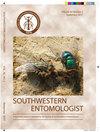Parámetros Biológicos y Poblacionales del Parasitoide Trichopria drosophilae1 Reproducido a Diferentes Temperaturas
IF 0.4
4区 农林科学
Q4 ENTOMOLOGY
引用次数: 0
Abstract
The parasitoid Trichopria drosophilae (Perkins) (Hymenoptera: Diapriidae) is commercially reared using a Drosophila melanogaster Meigen (Diptera: Drosophilidae). We evaluated biological and population parameters of T. drosophilae reared at 23, 25, 27, and 29°C, and the biological parameters of the offspring (= transgenerational effects). As the temperature increased, higher values were found in the intrinsic rate of increase (rm), finite rate of increase (λ), net reproduction rate (Ro), and shorter egg-to-adult duration, but no differences were found in sexual proportion, neither in the mean generation time (T), nor doubling time (D). With respect to transgenerational effects (= F2), as temperature increased, a concave quadratic relationship was recorded in the size and fecundity of the offspring reproduced at different temperatures, registering higher numerical values at 25 and 27°C. These results indicate that it is not recommended to reproduce T. drosophilae at 29°C because, although the colony would be more prolific, the adults would be of low quality.不同温度下果蝇毛滴虫的生物学和种群参数
寄生性果蝇毛蝇(Perkins)(膜翅目:双翅目:果蝇科)是用黑腹果蝇Meigen(双翅目:果蝇科)进行商业饲养的。我们评估了在23、25、27和29℃条件下饲养的果蝇的生物学和种群参数,以及后代的生物学参数(=跨代效应)。随着温度的升高,内在增殖率(rm)、有限增殖率(λ)、净繁殖率(Ro)和从卵到成虫的持续时间均有所增加,但在两性比例、平均世代时间(T)和加倍时间(D)方面均无差异。在不同温度下繁殖后代的大小和繁殖力呈凹二次型关系,在25℃和27℃时数值较高。这些结果表明,不建议在29°C的温度下繁殖果蝇,因为虽然菌落的数量会增加,但成虫的质量会降低。
本文章由计算机程序翻译,如有差异,请以英文原文为准。
求助全文
约1分钟内获得全文
求助全文
来源期刊

Southwestern Entomologist
生物-昆虫学
CiteScore
0.60
自引率
25.00%
发文量
95
审稿时长
6-12 weeks
期刊介绍:
Manuscripts submitted for consideration for publication in the Southwestern Entomologist should report results of entomological research in the southwestern United States or Mexico or should report results of studies on entomological species, relevant to this region, which may be done elsewhere, provided such results are geographically applicable. Manuscripts that report results of routine laboratory or field experiments for which the primary purpose is gathering baseline data or those that report results of a continuous evaluation program such as preliminary pesticide evaluation experiments, species lists with no supporting biological data, or preliminary plant resistance evaluations are not acceptable. However, reports of experiments with insecticides, acaricides, and microbials are acceptable if they are comprehensive and include data related to economics, resistance, toxicology, or other broad subject areas. Bibliographies will not be published in Southwestern Entomologist.
 求助内容:
求助内容: 应助结果提醒方式:
应助结果提醒方式:


